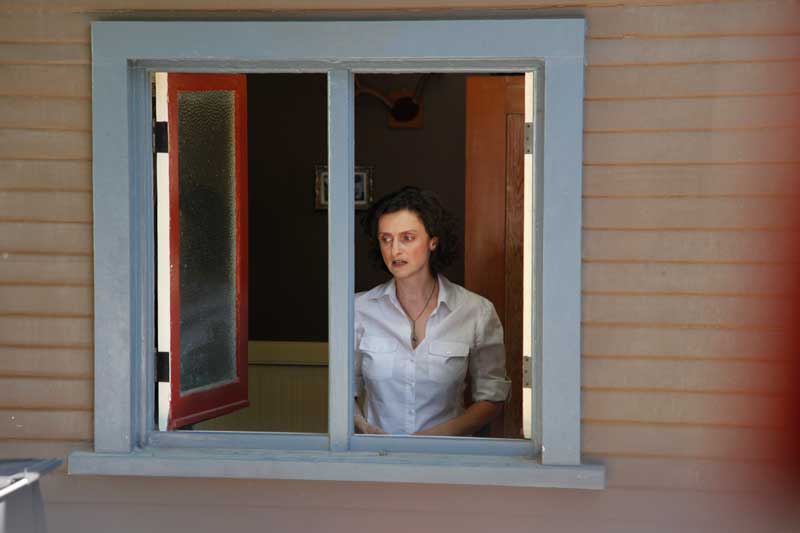|
The Paliament Film Collective's (Partial) Canon of Lesbian Cinema |
||||
 |
||||
Lily (Lisa Gornick). Still from The Owls (dir. Cheryl Dunye, 2010). Used with permission from the Parliament Film Collective. |
||||
A Lesbian Collective Aesthetic:
Making and Teaching The Owls
Page 4 of 6
Trans theorist and activist Jack (Judith) Halberstam was invited to participate in our cast and crew preproduction discussions about trans and butch identity and politics in the “lesbian” community. In the B-team’s taped documentary interviews with him, it came to our attention that the film’s six characters were, like the black characters, also unnamed in relation to their gender/sexuality identification, although given Cheryl’s interests, the initial assumption was that all the characters were probably women who were lesbians, and mostly butch. Just so, it turned out that Skyler chose to play her character Skye as an androgynous-looking but female-identified black woman, just as she chooses to enact herself. And here the so-called “generational divide” between the older and younger (in heart and theory, as much as age) queers working on the film presented itself: on one “side,” the nostalgic celebration of the lesbian or female or feminist; on the other, those seeking a more radical gender and sexual unmooring detached from outdated dependence on the “female.”
Given this split among us, the collective spent a lot of time, both on screen and off (many examples of this conversation appear in the film’s credit sequence), discussing our multiple choices for self-identification, from lesbian to queer, trans man, and Halberstam’s “transgender butch.” While the majority of participants in the making of the film identify as “lesbian,” there is one gay man and two currently straight women in the group who participated in the writing of this article. Then, as I’ve already said, Candi identifies as third-gender, Tania writes that she is “queer and trans-leaning,” and Campbell identifies as a “fag Daddy.” Furthermore, the eleven participants in this article include two Asian Americans, a Lebanese American, two women of African descent, two Jewish women, and an Icelandic, none of which is made visible in our descriptive prose (while some of which is visible when we speak on stage).
I go to these lengths of description and identification to point out that lesbian filmmaking remains a form of identity-based activism even as ours increasingly becomes an era of post–identity politics and self (another theme of the movie). Because we made The Owls collectively, we strove to hear the voices, commitments, theories, and politics of our diverse and committed crew, and these were decidedly not uniform. While all agreed to work for free on this lesbian feature film, divisions in the group were informative and definitive. Perhaps most painful for the Older Wiser Lesbians—the OWLs—in the group was a decidedly clear disavowal of the term “lesbian,” although thankfully not “feminist,” by mostly the younger members of our collective, who felt the word was too closely linked to the biologically female for their taste. After decades of trying to champion female-centered spaces, practices, and lifestyles it was difficult to account for the many championings of masculinity across our ranks, from trans men, gender-indeterminates, straight women, and gay men (not to mention lesbians).
The film changed to represent these debates about the politics of identity and visibility within its cast and crew: conversations about gender, sexuality, and community occur within both the narrative and documentary elements of the film as well as in its staging and cinematography.3 Therefore, I choose the word “lesbian” to describe our aesthetic—the visible and public rendering of our methods, forms, and practices—because this word forefronts the complexity and even conflict within our collective filmmaking in this moment, whereas “queer” currently works to soften out differences, conflict, and internal dissonance.4 Admittedly, the word “trans” might function similarly, marking our internal differences. However, since lesbians were by far the majority in this collective, I choose to use with the word “lesbian” to highlight our efforts at open-ended community expression.
Copyright © 2014. All rights reserved.